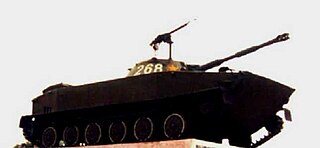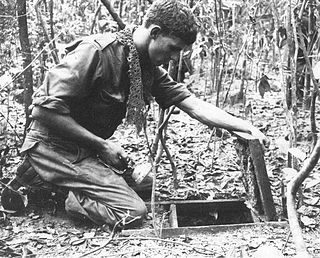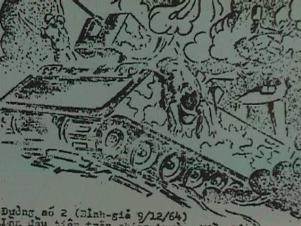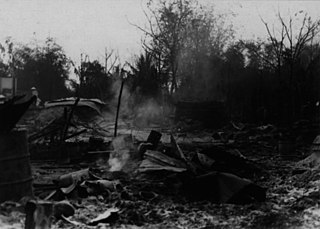
The Battle of Khe Sanh was conducted in the Khe Sanh area of northwestern Quảng Trị Province, Republic of Vietnam, during the Vietnam War. The main US forces defending Khe Sanh Combat Base (KSCB) were two regiments of the United States Marine Corps supported by elements from the United States Army and the United States Air Force (USAF), as well as a small number of Army of the Republic of Vietnam (ARVN) troops. These were pitted against two to three divisional-size elements of the North Vietnamese People's Army of Vietnam (PAVN).

Operation Starlite was the first major offensive action conducted by a purely U.S. military unit during the Vietnam War from 18 to 24 August 1965. The operation was launched based on intelligence provided by Major general Nguyen Chanh Thi, the Army of the Republic of Vietnam (ARVN) I Corps commander. III Marine Amphibious Force commander Lieutenant General Lewis W. Walt devised a plan to launch a pre-emptive strike against the Viet Cong (VC) 1st Regiment to nullify their threat to the vital Chu Lai Air Base and Base Area and ensure its powerful communication tower remained intact.

The Battle of Lang Vei began on the evening of 6 February 1968 and concluded during the early hours of 7 February, in Quảng Trị Province, South Vietnam. Towards the end of 1967, the 198th Tank Battalion of the People's Army of Vietnam's (PAVN) 202nd Armored Regiment received instructions from the North Vietnamese Ministry of Defense to reinforce the 304th Division as part of the Route 9–Khe Sanh Campaign. After an arduous journey down the Ho Chi Minh trail in January 1968, the 198th Tank Battalion linked up with the 304th Division for an offensive along Highway 9, which stretched from the Laotian border through to Quảng Trị Province. On 23 January, the 24th Regiment attacked the small Laotian outpost at Bane Houei Sane, under the control of the Royal Laos Army BV-33 "Elephant" Battalion. In that battle, the 198th Tank Battalion failed to reach the battle on time because its crews struggled to navigate their tanks through the rough local terrain. However, as soon as the PT-76 tanks of the 198th Tank Battalion turned up at Bane Houei Sane, the Laotian soldiers and their families retreated into South Vietnam.

The Battle of Ia Drang was the first major battle between the United States Army and the People's Army of Vietnam (PAVN), as part of the Pleiku Campaign conducted early in the Vietnam War, at the eastern foot of the Chu Pong Massif in the central highlands of Vietnam, in 1965. It is notable for being the first large scale helicopter air assault and also the first use of Boeing B-52 Stratofortress strategic bombers in a tactical support role. Ia Drang set the blueprint for the Vietnam War with the Americans relying on air mobility, artillery fire and close air support, while the PAVN neutralized that firepower by quickly engaging American forces at very close range.

The Green Berets is a 1968 American war film directed by John Wayne and Ray Kellogg, and starring Wayne, David Janssen and Jim Hutton, based on the 1965 novel by Robin Moore. Much of the film was shot in the summer of 1967. Parts of the screenplay bear little relation to the novel, although the portion in which a woman seduces a North Vietnamese communist general and sets him up to be kidnapped by Americans is from the book.

Operation Crimp, also known as the Battle of the Ho Bo Woods, was a joint US-Australian military operation during the Vietnam War, which took place 20 kilometres (12 mi) north of Cu Chi in Binh Duong Province, South Vietnam. The operation targeted a key Viet Cong headquarters that was believed to be concealed underground, and involved two brigades under the command of the US 1st Infantry Division, including the 1st Battalion, Royal Australian Regiment which was attached to the US 173rd Airborne Brigade. Heavy fighting resulted in significant casualties on both sides, but the combined American and Australian force was able to uncover an extensive tunnel network covering more than 200 kilometres, at the cost of 8 Australians and 14 Americans killed and 29 Australians and 76 Americans wounded.

The Battle of Bình Giã was conducted by the Viet Cong (VC) and People's Army of Vietnam (PAVN) from December 28, 1964, to January 1, 1965, during the Vietnam War in Bình Giã, Phước Tuy province, South Vietnam.

Robert Emmett O'Malley is a United States Marine veteran who was the first Marine Corps recipient of the Medal of Honor in the Vietnam War. He received the medal for his actions as a corporal on August 18, 1965, during Operation Starlite.

The Hill Fights took place during the Vietnam War between the People's Army of Vietnam (PAVN) 325C Division and United States Marines on several hill masses north of the Khe Sanh Combat Base in northwest Quảng Trị Province.

The Battle of Gang Toi was fought during the Vietnam War between Australian troops and the Viet Cong. The battle was one of the first engagements between the two forces during the war and occurred when A Company, 1st Battalion, Royal Australian Regiment struck a Viet Cong bunker system defended by Company 238 in the Gang Toi Hills, in northern Bien Hoa Province. It occurred during a major joint US-Australian operation codenamed Operation Hump, involving the US 173rd Airborne Brigade, to which 1 RAR was attached. During the latter part of the operation an Australian rifle company clashed with an entrenched company-sized Viet Cong force in well-prepared defensive positions. Meanwhile, an American paratroop battalion was also heavily engaged in fighting on the other side of the Song Dong Nai.

Operation Bribie, also known as the Battle of Ap My An, was fought during the Vietnam War in Phuoc Tuy province between Australian forces from the 6th Battalion, Royal Australian Regiment and two companies of Viet Cong from D445 Battalion, likely reinforced by North Vietnamese regulars. During the night of 16 February the Viet Cong attacked a South Vietnamese Regional Force compound at Lang Phuoc Hai, before withdrawing the following morning after heavy fighting with South Vietnamese forces. Two hours later, a Viet Cong company was reported to have formed a tight perimeter in the rainforest 2 kilometres (1.2 mi) north of Lang Phuoc Hai, near the abandoned hamlet of Ap My An. In response, the Australians deployed a quick reaction force. Anticipating that the Viet Cong would attempt to withdraw, as they had during previous encounters, forces from the 1st Australian Task Force were inserted to block the likely withdrawal route in the hope of intercepting and destroying them.

Operation Prairie was a U.S. military operation in Quảng Trị Province, South Vietnam that sought to eliminate People's Army of Vietnam (PAVN) forces south of the Demilitarized Zone (DMZ). Over the course of late 1965 and early 1966 the Viet Cong (VC) and the PAVN intensified their military threat along the DMZ. The tactical goal of these incursions was to draw United States military forces away from cities and towns. Operation Hastings, a series of actions in defense of the DMZ, lasted from 15 July to 3 August 1966. It was considered a strategic success. Operation Prairie was conceived as a larger, longer mission covering the same areas along the DMZ.

The Battle of Suoi Bong Trang was an engagement fought between US, Australian and New Zealand forces, and the Viet Cong and North Vietnamese Army during the Vietnam War. The battle occurred during Operation Rolling Stone, an American security operation to protect engineers building a tactically important road in the vicinity of Tan Binh, in central Binh Duong Province, 30 kilometres (19 mi) north-west of Bien Hoa airbase. During the fighting, soldiers from the US 1st Brigade, 1st Infantry Division and the 1st Battalion, Royal Australian Regiment, which had been attached for the operation, fought off a regimental-sized Viet Cong night assault. Repulsed by massed firepower from artillery and tanks, the Viet Cong suffered heavy casualties and were forced to withdraw by morning. After the attack, the Americans and Australians made no attempt to pursue the Viet Cong, focusing on securing the battlefield and evacuating their own casualties. The Viet Cong continued to harass the American sappers with occasional sniper and mortar fire, but these tactics proved ineffective, and the road was completed by 2 March.

The New Year's Day battle of 1968 was a military engagement during the Vietnam War in Tây Ninh province that began on the evening of 1 January 1968. It involved units assigned to the U.S. 25th Infantry Division and two regiments of the People's Army of Vietnam (PAVN). The battle was known as the Battle of Fire Support Base Burt, or the Battle of Suoi Cut. This is not the same location as Suối Cắt village in northern Vietnam.

Operation Kentucky was a multi-battalion operation conducted by the United States Marine Corps in the area south of the DMZ in Quảng Trị Province. This was another operation to secure the Con Thien area from the People's Army of Vietnam (PAVN). The operation ran from 1 November 1967 until 28 February 1969.

The Battle of Suối Châu Pha was fought during the Vietnam War between Australian troops and the Việt Cộng. The battle took place during Operation Ballarat, an Australian search and destroy operation in the eastern Hát Dịch area, north-west of Núi Đất in Phước Tuy province. Following a covert insertion the day before which had caught a number of Việt Cộng sentries by surprise, A Company, 7th Battalion, Royal Australian Regiment had patrolled forward unaware of the presence of a large Việt Cộng main force unit nearby. Clashing with a reinforced company from the Việt Cộng 3rd Battalion, 274th Regiment, a classic encounter battle ensued between two forces of roughly equal size. Fought at close quarters in dense jungle amid a heavy monsoon rain, both sides suffered heavy casualties as neither was able to gain an advantage. Finally, after a battle lasting several hours, the Australian artillery proved decisive and the Việt Cộng were forced to withdraw, dragging many of their dead from the battlefield after having suffered crippling losses.
The Battle of Hill 488 was a military engagement of the Vietnam War that took place on the night of 15–16 June 1966. A small United States Marine Corps (USMC) reconnaissance platoon inflicted large casualties on regular People's Army of Vietnam (PAVN) and Viet Cong (VC) fighters before withdrawing with only a few dead.

Operation Byrd was a security operation conducted during the Vietnam War by the U.S. 2nd Battalion, 7th Cavalry Regiment and the Army of the Republic of Vietnam (ARVN) 44th Regiment in Bình Thuận Province, South Vietnam from August 1966 to 1 December 1967.

Operation Muscatine was a security operation conducted during the Vietnam War by the US Army in Quảng Ngãi Province, South Vietnam from 18 December 1967 to 10 June 1968. During this operation on 16 March 1968 the 1st Battalion, 20th Infantry Regiment and the 4th Battalion, 3rd Infantry Regiment carried out the My Lai Massacre.

The Thạnh Mỹ Massacre was a massacre of South Vietnamese civilians committed by the Viet Cong (VC) during the Vietnam War, in Thạnh Mỹ hamlet, Phú Thạnh commune, Quế Sơn District, Quảng Nam Province, South Vietnam on 11 June 1970. The hamlet, which was pro-government and defended by US Marines and South Vietnamese militia, was attacked by the VC in the early morning of 11 June. Under cover of a mortar barrage VC sappers set fire to houses and killed civilians either by shooting to throwing explosives into their shelters. The Marines and South Vietnamese forces engaged with the VC and called in artillery support. By 03:15 the VC began to withdraw and the Marines reoccupied the village and began evacuating the wounded.



















